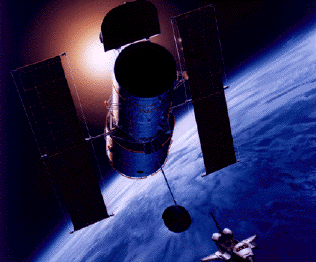
| Hubble Space Telescope | ||||||
 |
||||||
|---|---|---|---|---|---|---|
| The first of NASA's Great Observatories for Space Astrophysics | ||||||
| Hubble | Repairs | Science | History | Spectrum | Resources | Great Observatories |
In a series of five spacewalks to upgrade the Hubble Space Telescope, astronauts working out of the space shuttle Columbia in March 2002 repaired, fueled and upgraded the gigantic instrument for a deeper and clearer view of the cosmos.
Click to enlarge NASA cutaway drawing of Hubble
While working on the satellite, the crew spent a record total of 35 hours 55 minutes from March 4-9 outside of the shuttle 360 miles above Earth. They released Hubble back into its own orbit on March 9.
The major repairs and upgrades to the satellite telescope included:The next service mission to Hubble is scheduled for 2004. That could be the last. The satellite telescope is scheduled for use until 2010. Some time after that, it is to be retrieved for display at the Smithsonian Institution in Washington, D.C.
- A pair of new solar wings were added to Hubble. The new arrays are smaller, but 20-percent more powerful.
- A new reaction wheel assembly was installed to help aim Hubble. The satellite has four such devices.
- The 12-year-old telescope's power control unit (PCU) was replaced. To accomplish their chore, the crew had to power down and restart Hubble for the first time since it was placed in space by shuttle Discovery on April 25, 1990.
- A new Advanced Camera for Surveys (ACS), about the size of a telephone booth, was installed to improve Hubble images of the cosmos by tenfold. ACS replaced the Faint Object Camera, which had been the last remaining original Hubble camera. ACS will be used remotely by astronomers on the ground to search for extra-solar planets and to explore in more detail the ancient fringes of the Universe.
- A new cryogenic cooler and radiator, designed to chill a camera that needs extremely cold temperatures to function (-334 degrees Fahrenheit or -203 degrees Celsius), was installed. The Near Infrared Camera and Multi-Object Spectrometer (NICMOS) had gone out of service in 1999 after a small leak ruined the original cooling mechanism.
Hubble is controlled by the Space Telescope Science Institute in Baltimore.
The five U.S. space shuttle flights to deliver and service Hubble:A follow-on telescope to replace Hubble is being designed to provide even clearer pictures of our Universe.
- Shuttle flight number 35, known officially as STS-31, in 1990 delivered the Hubble Space Telescope (HST) to orbit above Earth.
- Shuttle flight 59, STS-61, in 1993 serviced the space observatory and installed corrective optics.
- Shuttle flight 82, STS-82, in 1997 serviced HST and upgraded its scientific capabilities by installing two state-of-the-art instruments.
- Shuttle flight 96, STS-103, in 1999 serviced and upgraded Hubble.
- Shuttle flight 108, STS-109, in 2002 serviced the telescope, installed the advanced new camera system, reactivated the infrared camera, installed new solar arrays, and installed a new power controller unit.
Hubble Repairs Science History Spectrum Resources
Great Observatories Telescopes Deep Space Cover E-Mail
© 2002 Space Today Online